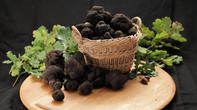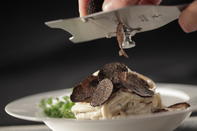Truffle farming in South Africa is a young but growing industry, focussing on the production of mostly French black truffles associated with oak trees. It is a highly technical farming enterprise that requires a cool climate, inoculated oak trees, patience and trained sniffer dogs...

How to Farm Truffles
Cultivating truffles depends on the technology available to inoculate host trees with spores of the truffle fungus, which occurs under tightly controlled conditions.
To grow truffles and establish a truffière (a piece of land where truffles are grown) the climate has to be right. In South Africa, truffles can only be grown in areas that are cold enough; the average day and night (winter) temperature needs to be 8°C. Suitable regions include areas of the Western Cape, KwaZulu-Natal Midlands, Dullstroom/Machadadorp and around Clarens.
Any soil type is suitable for truffles, but good drainage is non-negotiable. Soil pH needs to be adjusted to 7.9 and irrigation (to be installed prior to planting) needs to supplement rainfall to a total water availability of 4 000 to 6 000 m3 per year.
Seedlings of specific trees (associated with the specific species of truffles that will be grown in the area) are inoculated with truffle spores, which are the ‘seeds’ of fungi. The seedlings are then allowed to grow in sterile media.
About 18 months after inoculation, the ‘truffle trees’ are transplanted into orchards and at least another four years will pass before truffles can be harvested near the roots of the trees.
In South Africa, English and evergreen oak trees are used for truffle farming. According to Volker Miros from Woodford Truffles, hazel trees are not used any more. ‘Even though they produce truffles early, the process of sucker removal (shoots that grow vertically from the base of a trunk) creates a lot of extra work.’
On average, truffle yields in Europe may be between 28 and 39 kg per hectare, but with improved farming methods and management, yields may be up to 120 kg/ha.
South African truffle orchards are still young and estimates are low. Expected truffles yields and previous yields are often not reported, yet one South African truffle farmer has disclosed his estimate of 100 kg for 2020. This is about 5 - 10 kg per hectare.
Harvesting Truffles
Truffles are harvested in small quantities about four years after planting the trees, but there are industry tricks to shorten this time, acknowledges Mr Miros. ‘A harvest of 90 to 120 kg/ha in the tenth year is considered very good and certainly profitable.’
The black Périgord truffles are harvested between June and August in South Africa. Truffles are mature and ready for harvest when they are black and warty on the outside and have a light veined interior interspersed with black spores.
A trained dog is taken into the orchard and walked against the wind to sniff out truffles, which gives off the typical umami smell that rises up through the soil. In the past, pigs were used, but this is no longer a common practice as they are too eager to eat the truffles.
The truffles are then hand-dug out the ground. Truffles are found up to 40 cm deep in the sandy soils and also just below the surface in clay soils, says Volker Miros of Woodford Truffles in Hout Bay.
Truffle producers in the southern hemisphere (such as South Africa, Chile and Australia) export to Europe during the northern hemisphere summer, when European truffle supplies are low.
Storing and Eating Truffles

When stored at 4°C, a fresh truffle will last for up to 18 days. However, it loses a lot of its umami flavour over time.
Truffles are mostly eaten raw; thinly shaven over pasta, on pizzas, in risottos or to infuse sauces and warm dishes. The Burgundy/black summer truffle is best eaten cooked.
Consumers are advised to read the label of products containing truffles. If it says ‘truffle flavour’ it is fake. Truffles cannot withstand chemical processing so even if labels state ‘natural truffle flavour’ it means that the flavour is extracted from a natural source such as shiitake mushrooms.
By Marinda Louw